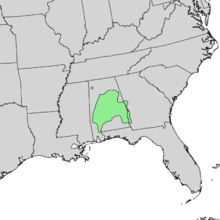Aesculus parviflora
| Bottlebrush Buckeye | |
|---|---|
| | |
| Scientific classification | |
| Kingdom: | Plantae |
| (unranked): | Angiosperms |
| (unranked): | Eudicots |
| (unranked): | Rosids |
| Order: | Sapindales |
| Family: | Sapindaceae |
| Genus: | Aesculus |
| Species: | A. parviflora |
| Binomial name | |
| Aesculus parviflora Walt. | |
 | |
| Natural range | |
Aesculus parviflora (bottlebrush buckeye); syn. Aesculus macrostachya Michx., Pavia macrostachya (Michx.) Loisel. is a species of Aesculus native to open woodlands of the southeastern United States. It is also called "dwarf horse chestnut" in recognition of its resemblance to its more famous relative A. hippocastanum.
It is a deciduous suckering shrub growing to 3-5 m tall. The leaves are arranged in opposite pairs, palmately compound with 5-7 leaflets, each leaflet short-stalked, 12-22 cm long and 5-10 cm broad, with an entire margin. The flowers are produced in conspicuous erect panicles 20-30 cm long resembling a traditional bottle brush, each flower with a tubular calyx, small white petals, and several protruding 3-4 cm long stamens.
The Latin specific epithet parviflora means "small-flowered".[1]
Cultivation and uses
It is grown as an ornamental plant in gardens, where its August flowering attracts butterflies. The naturalist, explorer and plant collector William Bartram first noted this undescribed shrub on his travels through Carolina, Georgia and Florida in 1773-78.[2] Though an old example was still to be found in Bartram's Garden, Philadelphia, in 1930,[3] the shrub has never become common in Eastern American gardens.
Aesculus parviflora was introduced to British horticulture through the activities of John Fraser, who made his first botanizing trip through the American South in 1785. Fraser's finds were distributed among English nurserymen like Lee and Kennedy or Loddiges or to private patrons, and the shrub was "to be met with in most of our nurseries" by 1820.[4] This plant has gained the Royal Horticultural Society's Award of Garden Merit.[5]
References
- ↑ Harrison, Lorraine (2012). RHS Latin for gardeners. United Kingdom: Mitchell Beazley. p. 224. ISBN 9781845337315.
- ↑ Noted by Alice M. Coats, Garden Shrubs and Their Histories (1964) 1992, s.v. "Aesculus"; Bartram's botanizing explorations were recorded in his Travels through North and South Carolina, Georgia, East and West Florida, the Cherokee Country, etc., 1791.
- ↑ Coats 1992.
- ↑ Quoted in Coats 1992.
- ↑ "Aesculus parviflora". Royal Horticultural Society. Retrieved 25 July 2013.
- Pink, A. (2004). Gardening for the Million. Project Gutenberg Literary Archive Foundation.
- Plants for a Future: Aesculus parviflora
- NRCS: USDA Plants Profile: Aesculus parviflora
| Wikimedia Commons has media related to Aesculus parviflora. |